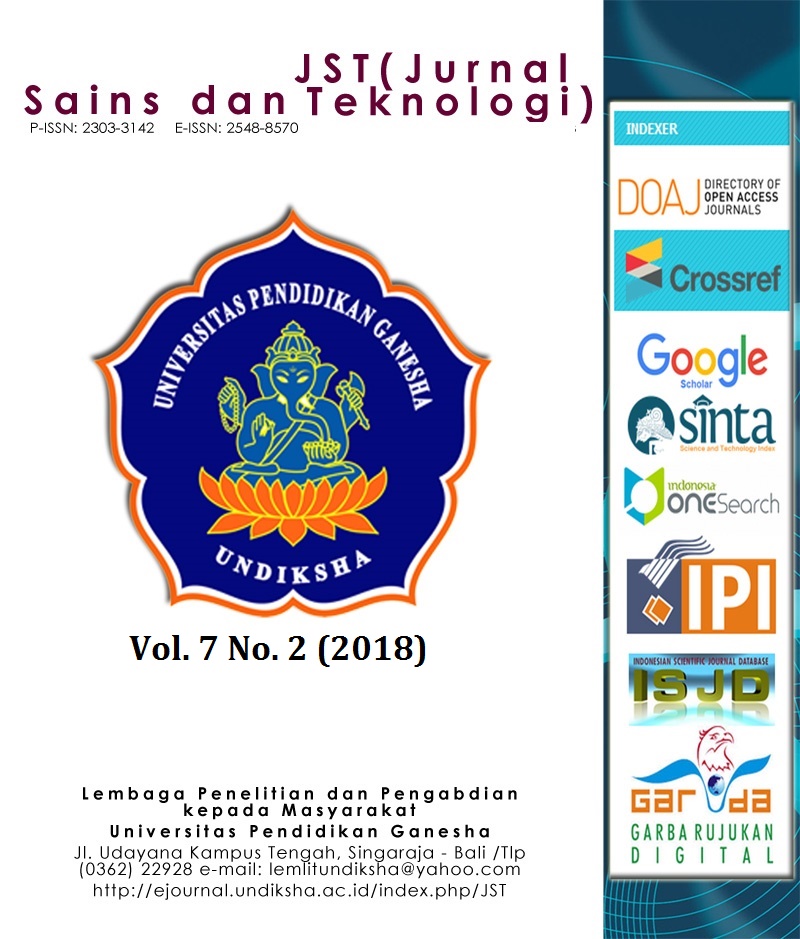KOMBINASI DCT DAN BEAUFORT CHIPER UNTUK PENINGKATAN KEAMANAN HAK CIPTA CITRA DIGITAL
DOI:
https://doi.org/10.23887/jstundiksha.v7i2.13795Abstract
Informasi penting seperti hak cipta tentunya perlu diamankan, terlebih saat era digital saat ini yang semakin canggih. Pengamanan informasi dapat dilakukan dengan teknik kriptografi atau penyandian. Sedangkan untuk pengamanan hak cipta dapat dilakukan dengan teknik watermarking. Penelitian ini mengkombinasi teknik kriptografi dan watermarking. Sebelum watermark disisipkan watermark disandikan terlebih dahulu. Metode watermarking yang diusulkan adalah DCT dan metode kriptografi yang diusulkan adalah Beaufort cipher. DCT dipilih karena merupakan transformasi domain yang tahan terhadap macam-macam manipulasi, cukup ringan dalam kalkulasi dan menghasilkan watermarking yang impercept. Sedangkan Beaufort cipher merupakan algoritma yang sederhana tapi sangat aman untuk pengamanan data. Alat ukur yang digunakan dalam eksperimen adalah SSIM, CC dan analisis histogram. Berdasarkan pengukuran terhadap hasil eksperimen dari metode yang diusulkan didapatkan hasil watermarking yang tahan terhadap serangan, impercept, dan aman.References
AL-Gindy, A., Zorrilla, A. M., & Beyrouti, B. (2015). DCT Watermarking Technique Using Image Normalization. International Conference on Developments of E-Systems Engineering. Liverpool.
Al-Najjar, H. M., & Al-Najjar, A. M. (2012). Multi-Chaotic Image Encryption Algorithm Based on One Time Pads Scheme. International Journal of Computer Theory and Engineering, 4(3), 350-353.
Gonzalez, R. C., Woods, R. E., & Eddins, S. L. (t.thn.). ImageProcessingPlace.com. Diambil kembali dari Image Database: http://www.imageprocessingplace.com/downloads_V3/root_downloads/image_databases/standard_test_images.zip
Gunjal, M., & J. J. (2014). Image Steganography Using Discrete Cosine Transform (DCT) and Blowfish Algorithm. International Journal of Computer Trends and Technology, XI(4), 144-150.
Handoyo, A. E., Setiadi, D. R., Rachmawanto, E. H., Sari, C. A., & Susanto, A. (2018). Teknik Penyembunyian dan Enkripsi Pesan pada Citra Digital dengan Kombinasi Metode LSB dan RSA. Jurnal Teknologi dan Sistem Komputer, 37-43.
Patra, J. C., Kishore, A. K., & Bornand, C. (2011). Improved CRT-based DCT Domain Watermarking Technique with Robustness Against JPEG Compression for Digital Media Authentication. International Conference on Systems, Man, and Cybernetics (SMC). Anchorage.
Setiadi, D. R., Rachmawanto, E. H., & Sari, C. A. (2017). Implementasi One Time Pad Kriptografi Pada Gambar Grayscale Dan Gambar Berwarna. Proceeding SENDI_U, (hal. 50-56). Semarang.
Setiadi, D. R., Rachmawanto, E. H., & Sari, C. A. (2017). Kombinasi Algoritma One Time Pad dan Chaotic Sequence dalam Optimasi Enkripsi Gambar. Jurnal Teknik Mesin, Elektro, dan Ilmu Komputer, 483-488.
Singh, S., Siddiqui, T. J., Singh, R., & Singh, H. V. (2011). DCT-
domain Robust Data Hiding Using Chaotic Sequence. International Conference on Multimedia, Signal Processing and Communication Technologies. Aligarh.
Tornea, O., Borda, M. E., Pileczki, V., & Malutan, R. (2011). DNA Vernam Cipher. International Conference on E-Health and Bioengineering. Iaşi.
Widyastuti, N. (2014). Pengembangan Metode Beaufort Cipher
Downloads
Published
How to Cite
Issue
Section
License
Authors who publish with the Jurnal Sains dan Teknologi (JST) agree to the following terms:
- Authors retain copyright and grant the journal the right of first publication with the work simultaneously licensed under a Creative Commons Attribution License (CC BY-SA 4.0) that allows others to share the work with an acknowledgment of the work's authorship and initial publication in this journal.
- Authors are able to enter into separate, additional contractual arrangements for the non-exclusive distribution of the journal's published version of the work (e.g., post it to an institutional repository or publish it in a book), with an acknowledgment of its initial publication in this journal.
- Authors are permitted and encouraged to post their work online (e.g., in institutional repositories or on their website) prior to and during the submission process, as it can lead to productive exchanges, as well as earlier and greater citation of published work. (See The Effect of Open Access)
















